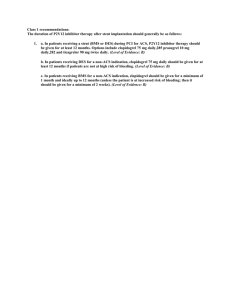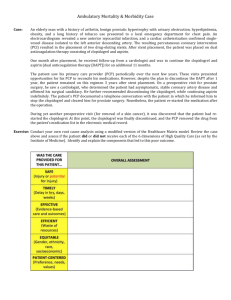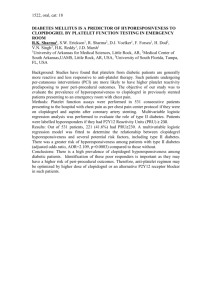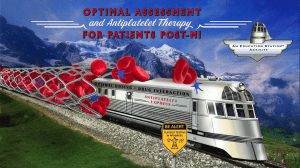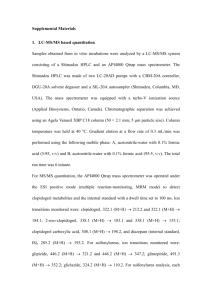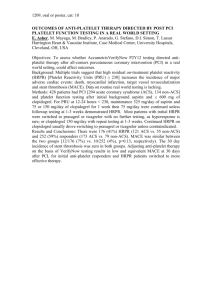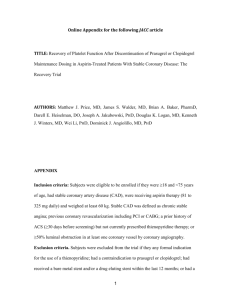Journal Club - University of Toledo
advertisement
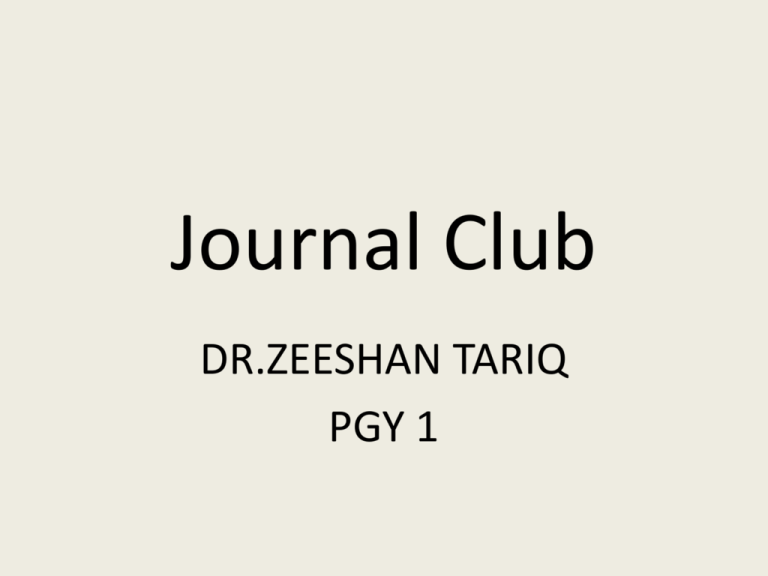
Journal Club DR.ZEESHAN TARIQ PGY 1 Clinical Scenario • A 69 years old male is getting discharged from the hospital where he was admitted for an acute MI. In addition to other medications he is also getting discharged on Aspirin and Plavix. Should he get a PPI for GI side effects??? What are the recommendations? • Compared with ASA alone, the combination of Clopidogrel and ASA significantly reduces the incident of recurrent coronary events following acute MI. • Yusuf S, Zhao F, Mehta SR, et al. Effects of clopidogrel in addition to aspirin in patients with acute coronary syndromes without ST-segment elevation. N Engl J Med 2001;345:494-502 What are the recommendations? • Recent guidelines published by the American Heart Association, the American College of Gastroenterology and the American College of Cardiology advocate proton pump inhibitor therapy for the majority of patients receiving ASA after myocardial infarction, including all patients aged 60 years or older. • Bhatt DL, Scheiman J, Abraham NS, et al. ACCF/ACG/AHA 2008 expert consensus document on reducing the gastrointestinal risks of antiplatelet therapy and NSAID use: a report of the American College of Cardiology Foundation Task Force on Clinical Expert Consensus Documents. Circulation 2008;118:1894-909 Interaction between Clopidogrel and PPI Mechanism of Action of Clopidogrel • Clopidogrel is a prodrug that is converted in the liver to an active thiol metabolite. • Irreversibly inhibits the platelet P2Y12 adenosine diphosphate receptor. • Bioactivation mediated by hepatic cytochrome P450 isoenzymes, 2C19 • Cytochrome P450 2C19 dramatically influences the antiplatelet effect . Effect of PPI on Cytochrome P450 2C19 • Drugs that inhibit this enzyme may reduce the antiplatelet effect of clopidogrel. • Emerging evidence suggests that some PPI can inhibit cytochrome P450 2C19. • Influencing clopidogrel's pharmacokinetics. Effect of PPI on Cytochrome P450 2C19 • Small DS, Farid NA, Payne CD, et al. Effects of the proton pump inhibitor lansoprazole on the pharmacokinetics and pharmacodynamics of prasugrel and clopidogrel. J Clin Pharmacol 2008;48:475-84 • Li XQ, Andersson TB, Ahlstrom M, et al. Comparison of inhibitory effects of the proton pump-inhibiting drugs omeprazole, esomeprazole, lansoprazole, pantoprazole, and rabeprazole on human cytochrome P450 activities. Drug Metab Dispos 2004;32:821-7 • Gilard M, Arnaud B, Cornily JC, et al. Influence of omeprazole on the antiplatelet action of clopidogrel associated with aspirin: the randomized, double-blind OCLA (Omeprazole CLopidogrel Aspirin) study. J Am Coll Cardiol 2008;51:256-60 Published at www.cmaj.ca on Jan. 28, 2009 Methods Setting • A population-based nested case–control study among Ontario residents aged 66 years or older who were discharged from hospital between Apr. 1, 2002, and Dec. 31, 2007, after treatment for acute MI. • These individuals had universal access to hospital care, physicians' services and prescription drug coverage. • The study was approved by the Research Ethics Board of Sunnybrook Health Sciences Centre. Data Sources • Computerized prescription records of the Ontario Public Drug Program. • Hospital admissions using the Canadian Institute for Health Information Discharge Abstract Database. • Ontario Health Insurance Plan database. Figure 1: Study design Juurlink, D. N. et al. CMAJ 2009;180:713-718 Copyright ©2009 Canadian Medical Association or its licensors Identification of Patients • A cohort of patients aged 66 years or older who filled a prescription for clopidogrel within 3 days after hospital discharge following treatment for acute myocardial infarction. • The date of discharge from hospital served as the date of cohort entry. Exclusion Criteria • Patients who had received clopidogrel, ticlopidine or dipyridamole in the year before admission to hospital. • Patients in long-term care facilities. • Those who received, within 90 days before or after the index date,PPI to eradicate Helicobacter pylori. Cases • Patients who died or were readmitted for myocardial infarction within 90 days after the initial hospital discharge. Controls • Random sampling with replacement was used from the same cohort of patients to identify the controls. • These individuals were at risk but were not readmitted because of myocardial infarction before the index date. • Controls were matched to cases on age , receipt of PCI in hospital, date of hospital discharge and predicted probability of short-term mortality. Exposure to PPIs • Current (within 30 days before the index date) • Previous (31–90 days before the index date) • Remote (91–180 days before the index date) Statistical Analysis • Conditional logistic regression was used to estimate the odds ratio (OR) for the association between reinfarction and exposure to a PPI, using as the reference group patients with no prescription for a PPI in the previous year Statistical Analysis Adjustments were made for: • • • • • • Age Sex Income quintile Charlson comorbidity index Length of stay in hospital Medical conditions previously shown to correlate with short-term mortality following acute myocardial infarction • Other commonly used cardiovascular medications • Other cytochrome P450 2C19 and cytochrome P450 3A4 inhibitors or inducers • Use of H2-receptor antagonists Statistical Analysis • Stratified analysis of the risk of recurrent MI with pantoprazole or with other PPI. • Pantoprazole does not inhibit cytochrome P450 2C19 and therefore should not interfere with the metabolic activation of clopidogrel. • Other PPI do inhibit cytochrome P450 2C19 and can be expected to attenuate clopidogrel's beneficial effects. Table 1 Juurlink, D. N. et al. CMAJ 2009;180:713-718 Copyright ©2009 Canadian Medical Association or its licensors Results Results • A significant association between readmission because of MI and current use of a PPI (adjusted OR 1.27, 95% confidence interval [CI] 1.03–1.57) but not with earlier use of these drugs. • No association between recurrent myocardial infarction and use of histamine H2-receptor antagonists. • No such association among patients not treated with clopidogrel. Results • In the stratified analysis of the type of PPI used, pantoprazole was not associated with recurrent MI among patients receiving clopidogrel. • In contrast, compared with no treatment, other PPI were collectively associated with a 40% increase in the risk of recurrent MI within 90 days of hospital discharge (OR 1.40, 95% CI 1.10–1.77) Figure 2: Association between acid-reducing therapies and adverse outcomes Juurlink, D. N. et al. CMAJ 2009;180:713-718 Copyright ©2009 Canadian Medical Association or its licensors Table 2 Juurlink, D. N. et al. CMAJ 2009;180:713-718 Copyright ©2009 Canadian Medical Association or its licensors Interpretation • In older patients taking clopidogrel following MI, concomitant use of a PPI was associated with a significantly increased short-term risk of reinfarction. • It was estimated that 5% to 15% of early readmissions because of MI among patients taking clopidogrel could be the result of this drug interaction. Interpretation • No association was found with more remote use of a proton pump inhibitor or current use of histamine H2-receptor antagonists. • As predicted from its basic pharmacology, pantoprazole displayed no such association in a stratified analysis, whereas other proton pump inhibitors did. Interpretation • Indiscriminate treatment with PPI could result in thousands of additional cases of recurrent MI each year. • Potentially be avoided by preferentially using pantoprazole in patients taking clopidogrel. Cost Effectiveness • With annual sales of US$7.3 billion in 2007, clopidogrel is the drug with the second-largest sales volume worldwide. Top ten global products — 2007. IMS Midas Monthly. London (UK): IMS Health Inc.; December 2007. Conclusion of the Study • Among patients taking clopidogrel following acute MI, the concomitant use of a PPI that inhibits cytochrome P450 2C19 was associated with an increased risk of recurrent MI. • Pending further data, concomitant treatment with clopidogrel and PPI other than pantoprazole should be minimized when possible. • H2-receptor antagonist may be an alternative for patients who require acid-lowering therapy. Are the Results Valid? 1. Study Design • Population-based nested case-control study • RCTs can also demonstrate harm • Reasons that we usually do not find RCTs in Harm studies: 1. Unethical 2. Concern about rare and serious adverse effects Did Investigators Demonstrate Similarity in All known Determinants of Outcome? Did They Adjust for Differences in the Analysis? 1. No data on important cardiac risk factors such as smoking status, blood pressure and lipoproteins. 2. Data sets included only drugs listed on the provincial formulary, we can not identify use of nonprescription medications, particularly over-the-counter ASA. 3. Although cases and controls were matched on important predictors of outcome, some imbalance was evident in their measured characteristics. 4. Patients who either developed reinfarction or were prescribed PPI were sicker cohorts and with higher prevalence of such distinctive factors as diabetes, renal failure, and heart failure 5. Case group had a significantly higher percentage of diabetic patients compared to the matched control group (28.3% vs. 19.9%, p<0.001) a. Diabetic patients demonstrate poorer outcome post MI b. Diabetics have also been shown to have an attenuated response to clopidogrel mediated platelet inhibition 6. The study did not account for ethnicity, potentially relevant since genetic polymorphisms of cytochrome P450 2C19 leading to insufficient enzymatic activity are not equally distributed among individuals of white, Asian and African descent 7. It is also possible that by analyzing the Pantoprazole data separately a Type II error could have occurred. Were Exposed Patients Equally Likely to Be Identified in the Two Groups? • Because some patients take proton pump inhibitors intermittently, misclassification of exposure status is possible. Were the Outcomes Measured in the Same Way in the Groups Being Compared? • Ascertainment of exposure is not an issue unless effected by misclassification of exposure. • It was not addressed whether all three of the implicated proton pump inhibitors (omeprazole, lansoprazole, and rabeprazole) equally contributed to the reported odds ratio of 1.40. ( In vitro studies on Rabeprazole ) Was Follow-up Sufficiently Complete? • 69 month study period • Follow up not an issue in this study How Strong is the Association Between Exposure and Outcome? • Given the flaws inherent in a case-control design, higher odds ratios (e.g. >2) are generally required before the results can be seen as indicative of real risk. • Levine M, Waiter S, Lee H: et al. Users Guides to the Medical Literature IV. How to use an article about harm. JAMA 1994;271:1615-1619. FINAL CONCLUSION • The study suffers from the limitation inherent in any observational study: that exposed and unexposed patients may differ in prognosis at baseline. • No amount of adjustment and sensitivity analyses will overcome the impact of unmeasured confounders, and thus these studies could still be considered hypothesis-generating. FINAL CONCLUSION • Since the CURE trial showed a 20% relative risk reduction in vascular events with clopidogrel: 1. Is it reasonable to expect to accurately detect a lessening of that effect in observational studies, given the unavoidable confounding? 2. Is it plausible that there is truly an odds ratio of 1.27 for risk for reinfarction as seen in this study, which suggests that PPIs would more than completely negate the benefits of clopidogrel? Fox KA, Mehta SR, Peters R, et al. Benefits and risks of the combination of clopidogrel and aspirin in patients undergoing surgical revascularization for non-ST-elevation acute coronary syndrome: the Clopidogrel in Unstable angina to prevent Recurrent ischemic Events (CURE) Trial. Circulation. 2004;110:1202-8. FINAL CONCLUSION • Despite the limitations, this careful study based on a biologically plausible explanation should prompt avoidance of unnecessary PPI use with clopidogrel and further study of potentially important interaction in future randomized trials. • If a PPI is required, pantoprazole should be used preferentially in patients who are also receiving clopidogrel. THANK YOU ALL
